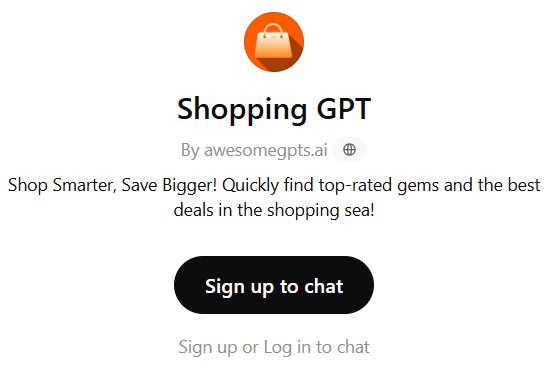
From search to sale, shopping with GPT could make e-commerce a one-window experience.
Online shopping is still a multi-tab chore: search here, compare there, check reviews somewhere else. Even with modern e-commerce platforms, the path from discovery to purchase is fragmented, clunky, and often overwhelming.
But what happens when the entire buying journey fits into a single conversation? With over 800 million users and growing, ChatGPT may soon blur the line between assistant and storefront. Unreleased code suggests OpenAI is testing a Shopify integration that would let users browse, review, and purchase products without ever leaving the chat.
If rolled out, shopping with GPT won’t just change how we buy. It could redefine where we buy. Imagine asking, “What’s the best blender under $100?” and checking out in seconds, all inside ChatGPT.
Shopping with GPT, ChatGPT your future shopping assistant
According to TechRadar, OpenAI may be preparing to turn ChatGPT into a fully functional shopping assistant, thanks to an upcoming integration with Shopify. Unreleased code discovered by Testing Catalog suggests users could soon browse, compare, and purchase products—all without leaving the chat window.
The new feature appears to embed:
Product listings from Shopify merchants
Pricing, shipping info, and user reviews
A “Buy Now” button for direct, in-chat checkout
Rather than linking out to third-party websites, ChatGPT would keep the full shopping experience inside the conversation. That means no more clicking away, entering credit card details elsewhere, or hunting for the same product again on another page.
Shopify merchants could gain instant visibility
For the millions of small sellers on Shopify, this integration could be a major opportunity. Rather than relying solely on SEO or social media algorithms, their products could appear directly in front of ChatGPT’s more than 800 million users.
This lowers the friction in the buying process. When users ask about “the best trail running shoes under $100,” ChatGPT wouldn’t just give links. It could offer real-time product suggestions, complete with checkout, embedded in the chat.
Adobe"AI improved the shopping experience for 92% of users, and 87% would use it for big or complex purchases."
A new era of AI-driven transactions
This development marks a shift from AI as a passive advisor to an active participant in commerce. OpenAI isn’t alone in this move toward “agentic commerce”, a growing field where AI tools go beyond suggestions and into decision-making and transactions.
Other players include:
Still, ChatGPT’s sheer scale could make it the front-runner. By merging AI assistance with seamless purchasing, OpenAI is positioning itself not just as a source of answers—but a place to act on them.
From thinking to doing
Until now, ChatGPT helped users plan, write, and research. Now it’s starting to “do.” The potential Shopify partnership would turn ChatGPT into a retail environment that learns preferences and streamlines decisions.
While it won’t replace every e-commerce platform, it might become the fastest path from question to purchase.
How ChatGPT currently handles shopping prompts
According to information from Analytics Insight, ChatGPT currently assists with shopping by offering recommendations. It also provides links that direct users to third-party websites to make purchases.
For example, one can ask ChatGPT “What are the top-rated noise-canceling headphones under $200?” and it yields relevant suggestions.
The AI model also explains why these phones are suitable based on specifications, real-world usage, and user reviews. This helps users gather information before making a purchase on an external site.

Preparing for the shift in shopping with GPT
Todd M. Piechowski, MPA, in his LinkedIn post, compared ChatGPT’s growing e-commerce role to Uber’s disruption of the taxi industry.
Expert Insights: Preparing for the Shift in Shopping with GPT
The potential integration of ChatGPT and Shopify could create a significant change in how consumers discover and buy products online. This development has implications for all sellers, including those on Amazon.
This potential change brings several key considerations for sellers:
- ChatGPT could become a primary way products are ranked and discovered. Listings with detailed information and accurate data from platforms like Shopify may perform better, while less comprehensive listings could become less visible.
- If users can purchase directly within ChatGPT, it could lead to fewer clicks on search engine results and fewer visits to marketplaces like Amazon. This shift in traffic patterns might cause advertising costs on traditional platforms to increase.
- The initial product discovery through ChatGPT might be free, but it’s possible that OpenAI could introduce fees or placements for prioritized visibility in the future.
- The valuable data about customer intent during shopping conversations would reside with OpenAI, potentially limiting the data insights available to sellers through their own tracking methods.
Given these potential shifts, it is important for sellers to take proactive steps:
- Ensure your product listings on platforms like Shopify are comprehensive, with accurate titles, complete attributes, and real-time inventory information. This will help your products rank well if ChatGPT becomes a primary discovery tool.
- Be ready to allocate budget for potential advertising opportunities within the ChatGPT interface to maintain visibility.
- Focus on building strong connections with customers after a purchase through email marketing, custom packaging, and loyalty programs. This can help encourage repeat business outside of the AI intermediary.
- Start thinking about how your brand and products can be presented and sold effectively within a conversational AI environment.
Amazon enters the agentic commerce arena
Amazon is integrating AI to reshape online shopping and strengthen its market position. These initiatives aim to improve user experience and extend Amazon’s reach.
"Buy for Me": shopping beyond Amazon
“Buy for Me” is a testing feature allowing in-app purchases from external brand websites. AI handles the purchase using encrypted data. Brands manage post-purchase processes.
This uses Amazon’s Bedrock AI. Brands gain visibility but face website AI compatibility needs.
Rufus & Alexa+: conversational commerce
Rufus is an in-app AI shopping assistant answering questions using Amazon and web data. Alexa+ will upgrade the voice assistant with stronger AI for complex tasks.
For sellers, including those working with an Amazon agency, success will rely on aligning product data with AI recommendations and natural language. Comprehensive listings are vital for AI understanding. New voice advertising methods will appear.
Nova Act: AI web automation
Nova Act is an Amazon AI that can autonomously navigate and interact with websites. It can perform tasks like searching and checkout. This technology will likely support future AI services.
For all sellers, a “machine-readable” online presence is crucial. Prioritize structured data and clear web protocols for AI agents. Optimization for algorithmic interpretation is increasingly important.





